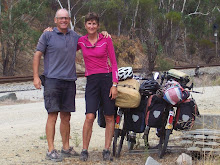At Pozieres are memorials to the Australians who suffered their worst losses here of any battle in their history. A nearby memorial marks where tanks were used for the first time ever - only 9 of the 32 British Mark 1 tanks deployed reached their objective.
At High Wood at Longueval is the extensive London Cemetery, with many unnamed graves.
Smaller shrines around the wood are even more poignant. A Cairn of 192 stones from the Highlands for missing sons of Scotland, and an oak tree in memory of the Public Schoolboys Regiment. So many mothers broken hearts.
We are camping "a la ferme"tonight. What a gorgeous place! Our tent is in a cherry orchard, perfumed by roses. Even the chickens are "tres jolies" and we have not spotted any noisy donkey!
A wander around the tiny hamlet reveals the first pre-war houses we have seen since Abbeyville, attractive brick farms with painted shutters set in lavender and rose gardens. Thunder rumbles continually and sheet lightening flashes over near hills -we are in for another sharp downpour after such a sultry day.
Our farmer is spraying his crops, next morning, but this hasn't diminished wildlife. There is an abundance of birds; Montagues and Hen Harriers swoop over the corn fields, Yellowhammer, Thrush, Sparrow, Jays and Skylarks are all more common than back home. Hares race away from us through cabbage fields.
St. Quentin has an enormous town square and ancient large Hotel de Ville to match. The town was a German HQ in WW1 so mostly destroyed. The population were evacuated in 1917. Their large Basilica is still being restored after being wrecked by a WW1 munitions train, blown up in the adjacent station. We meet a pair of Danish touring cyclists who are heading our way but are delayed as they need a new chain. They are on skinny bikes and carry rucksacks.
The village of Montbrehain N of St Q is where our next hosts live. Catherine is the village doctor, running her practice from her home - very like "Dr Finlay's Casebook". Their house is a large, handsome, brick farm house and outbuildings arranged around a courtyard. It was the home of the grandfather of Francois, who has restored it throughout including beautiful tiled and wood block floors. Somehow they manage to find time to tend the acre of garden from which they are self sufficient in fruit and veg.

C makes very tasty jam of which we sample orange and rhubarb and raspberry to accompany the delicious crepes F makes for breakfast next day. They have an album of cycle trips they made when their children were young, some 25 years ago. F had constructed a fantastic baby carriage, like a small Wild West covered wagon, which he towed (he said how heavy it was - 40kg!).
We continue on through a hedgeless farming landscape, spotting a deer watching from a wood edge. Every pond has very noisy frogs. The city of Laon is visible from many miles away as the Medieval Cathedral and old walled city is perched on a hill, rising out of the plain. We meet 3 Spanish touring cyclists here from the Canaries who are cycling to Paris from Maastricht.
Next we are on to Rheims, which also has an enormous fine Cathedral in the centre. The massive, intricate statues and lead gargoles are on a very impressive scale. There is canal path most of the last 5 miles to the centre apart from a long stretch of very potholed road, with no verge, where quarry lorries appear to be racing each other in both directions simultaneously - such fun! Our campsite is 5 miles on in a lovely wood. Two Dutch lady cyclists are camped here in the same type of tent as us and come over for a chat. They are cycling from Maastricht to Biarritz.
We look like a couple of laundry baskets the next day as we have hung our washing to dry on our panniers. It is dry by lunchtime. We have come across many"route barre" on this trip and ignore them, always finding a way round the road works. This time though the sign mentions something about the military. We decide that the sign doesn't apply to the footpath and carry on. Consequently we end up lost in the midst of an enormous military barracks! Glad to find a way out unchallenged, we then cross a large military exercise area, like Salisbury Plain. Next through farms with fields of white poppies. We lunch in a park at Sainte Menehould, where the Dominican monk who invented champagne was born in 1639 (Dom Perignon).

We have to take a rather busy road to avoid some big hills, then on farm roads again to a camp on a lake by Verdun. Tired after a tough cycle we treat ourselves to a meal in the camp restaurant - hungry enough to eat a horse, and as this is France, it was on the menu!

Tour miles to date 846.
Location:Albert to Verdun
